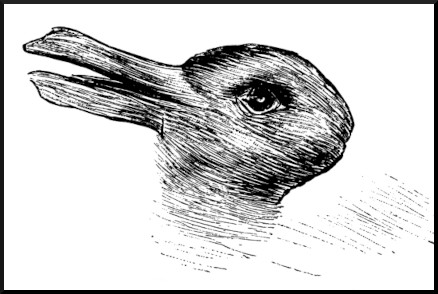Henri Bergson? Robertson Davies? Johann Wolfgang von Goethe? Thomas Carlyle? Anais Nin? Anonymous?

Question for Quote Investigator: One might see a duck when looking at the famous ambiguous image above, or one might see a rabbit. Perceiving one animal partially blocks the recognition of the other animal, and mental effort is required to switch one’s viewpoint. The influential French philosopher Henri Bergson and the Canadian novelist Robertson Davies have both been credited with a germane remark:
The eye sees only what the mind is prepared to comprehend.
Would you please explore the provenance of this statement?
Reply from Quote Investigator: QI has not yet found any substantive evidence linking the quotation to Henri Bergson who died in 1941.
An exact match occurred in the 1951 novel “Tempest-Tost” by Robertson Davies. One of the primary characters in the book observed two young lovers. Emphasis added to excerpts:1
At some distance from the path, under the trees, was a bench, and upon it were a boy and girl in a close embrace. Ordinarily Hector would not have noticed them, for the eye sees only what the mind is prepared to comprehend. He saw them now; Hector the actor, rather than Hector the teacher of mathematics took note of what they were doing.
Below are additional selected citations in chronological order.
The above remark falls within a family of sayings that comment about the dependence of perception on cognition and preconceptions.
The 1808 dramatic poem “Faust” by the major German literary figure Johann Wolfgang von Goethe contains the following line. Further analysis is available here:2
. . . each one sees what he carries in his heart.
In 1837 the Scottish philosopher and historian Thomas Carlyle referred to an expression with a meaning comparable to the quotation from Davies. Further analysis is available here:3
For indeed it is well said, ‘in every object there is inexhaustible meaning; the eye sees in it what the eye brings means of seeing.‘ To Newton and to Newton’s Dog Diamond, what a different pair of Universes; while the painting on the optical retina of both was, most likely, the same!
The 1961 work “Seduction of the Minotaur” by the prominent writer Anaïs Nin contained a related remark which she described as Talmudic. Further analysis is available here:4
We do not see things as they are, we see them as we are.
In 1963 a book reviewer in “The Baltimore Sun” in Maryland described a similar saying as an axiom:5
It is axiomatic that the eye sees only what the mind prepares it to see. The hunter sees the rabbit, the bird watcher the bird, and too many tourists see only the motels and gas stations.
In 1986 the words of Davies were recalled in the preface of “The Fitzhenry & Whiteside Book of Quotations”:6
If, indeed, there is nothing new under the sun, the reservoir of thought must be finite and it is not surprising that the same perception will be struck independently. Robertson Davies said, “The eye sees only what the mind is prepared to comprehend.”
In 1993 a message in the Usenet newsgroup alt.quotations credited Bergson; however, no citation was provided:7
The eye sees only what the mind is prepared to comprehend.
HENRI BERGSON
In 2006 the compilation “Wisdom for the Soul: Five Millennia of Prescriptions for Spiritual Healing” also credited Bergson:8
The eye sees only what the mind is prepared to comprehend.
~ Henri Bergson, 1859-1941 ~
In conclusion, Robertson Davies should receive credit for the quotation under examination based on his 1951 novel “Tempest-Tost”. Yet, other similar remarks were already in circulation. For example, Thomas Carlyle in 1837 referred to an earlier saying: “the eye sees in it what the eye brings means of seeing”.
Image Notes: An ambiguous image depicting a duck or a rabbit from the October 23, 1892 issue of Fliegende Blätter. Image accessed via Wikipedia.
Acknowledgement: Great thanks to dvs1 whose inquiry about the quotation from Robertson Davies initiated a cascade of explorations and articles including this one.
Update History: On April 12, 2025 the format of the bibliographical notes was updated.
- 1980 (Copyright 1951), Tempest-Tost by Robertson Davies, Chapter 3, Quote Page 116, Penguin Books, Harmondsworth, Middlesex, England. (Verified with scans) ↩︎
- 1851, Faust: A Dramatic Poem by Goethe (Johann Wolfgang von Goethe), Translation by A. Hayward, Third Edition, Prologue for the Theatre, Speaker: Merryman, Quote Page 33, Ticknor, Reed, and Fields, Boston, Massachusetts. (Google Books Full View) link ↩︎
- 1838, The French Revolution: A History by Thomas Carlyle, Volume 1: The Bastille, Book 1: Death of Louis XV, Chapter 2: Realised Ideals, Quote Page 5, Charles C. Little and James Brown, Boston, Massachusetts. (Google Books Full View) link ↩︎
- 1961 copyright, Seduction of the Minotaur by Anaïs Nin, Quote Page 124, The Swallow Press, Chicago, Illinois. (Afterword added in 1969; sixth printing in 1972) (Verified on paper in sixth printing 1972) ↩︎
- 1963 March 24, The Baltimore Sun, Natural History by George F. Carter (Professor of Geography, Johns Hopkins University), (Book review of “Face of North America” by Peter Farb), Quote Page 5A, Column 1, Baltimore, Maryland. (Newspapers_com) ↩︎
- 1986, The Fitzhenry & Whiteside Book of Quotations, Revised and Enlarged, Edited by Robert I. Fitzhenry, Section: Preface, Quote Page xiv, Fitzhenry & Whiteside Limited, Toronto. (Verified on paper) ↩︎
- 1993 November 1, Usenet discussion message, Newsgroup: alt.quotations, From: Bill Gascoyne @dcst16.dc, Organization: LSI Logic Corporation, Subject: Re: Can you identify these quotes? (Google Groups Search; Accessed November 3, 2016) link ↩︎
- 2006, Wisdom for the Soul: Five Millennia of Prescriptions for Spiritual Healing, Compiled and Edited by Larry Chang, Section: Vision / Visualization, Quote Page 736, Column 2, Gnosophia Publishers, Washington, D.C. (Verified with scans) ↩︎